NEWSLETTER 03
March 2024: London seafood institutions, the architecture of Turn End and what to do in Provence.
STYLE: WHAT WE ARE WEARING THIS EASTER
As we’re writing this, we just arrived in Bordeaux for a week of Easter holidays. Here’s to the opportunity to share a few favourites, new & old, that have us excited this time of year.
Nils
My vintage 90s Massimo Osti coat. It’s long, it’s brown, looks like suede, it’s double-breasted & fabulous! The coat revealed itself to me in a pile of clothes at a market dealer in Florence. The name on the label caught my eye: Osti is a legendary figure in fashion. An Italian textile engineer turned designer, he is characterised by a relentless pursuit of technical fabric experimentation. He revolutionised technical outerwear with ground-breaking garment dyeing techniques and high-performance fabrics. His legacy continues to inspire contemporary designers and his most famous brands like Stone Island thrive. This piece is from one of his lesser-known brands - Left Hand, launched in 1993. For the first seasons, the garments were produced using a novel fabric made from a procedure for pressing fibres, a method similar to that traditionally employed in the paper industry; which gave it it’s chamois-like texture.
My pair of Julius Tart Arnel sunglasses. Another Florentine find: I saw them last Easter at Bottega di Sguarsdi, a great local optician; put them on and loved the shape of this frame on me. The brand brings back a 1950s New York frame maker, recently revived by the founder’s nephew. The frames in question were worn by people with good taste in glasses, from JF Kennedy to James Dean and Albert Einstein. A favourite aspect is having personalised them by putting on pink polychromatic lenses on them - the ones that darken with the sun, you know the ones. Life through rose-tinted glasses at its best. The brand now manufactures in Japan and will be stocked by good opticians; also worth noting that a couple of specialty shops like Clutch Café in London or Beige Habilleur in Paris now have a small selection.


Georgina
Tank tops! The minute cold weather strikes I tend to lean heavily on a long sleeve rollneck jumper (think Diane Keaton in ‘Something’s Gotta Give’) and not emerge until it is safely over 15°C. This Spring, I stocked up on sleeveless basics from Flore Flore. I will be casting my rollneck aside a little earlier than usual, knowing that I’ll be able to layer up with cardigans should I get cold, that I can then tie around my shoulder or waist à la Linda. My favourite Flore Flore shapes so far are Esme and May - they both hit that 90s off-duty model shape and are made in the softest organic cotton that is sustainably sourced by founder Flòrian van Zuilen.
As a side note, Megan Strachan’s Substack newsletter came into my inbox on Saturday evening (if you aren’t signed up I would recommend), discussing moments of fashion and moments of not wanting to get dressed at all. I thought I would share it here as a reminder that there are times where we want to get excited and revisit clothes - which is why Nils and I put this post together; but also times when you might not want to dress up, and that's okay too. As Megan puts it, ‘there are days where we are wearing fashion. And there are days where we are wearing fashion armour.’
KITCHEN: LONDON SEAFOOD INSTITUTIONS
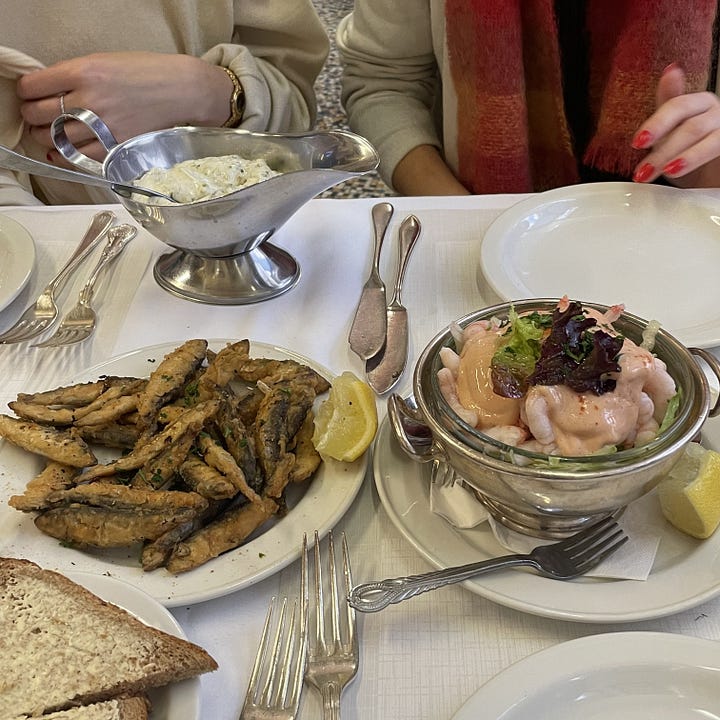
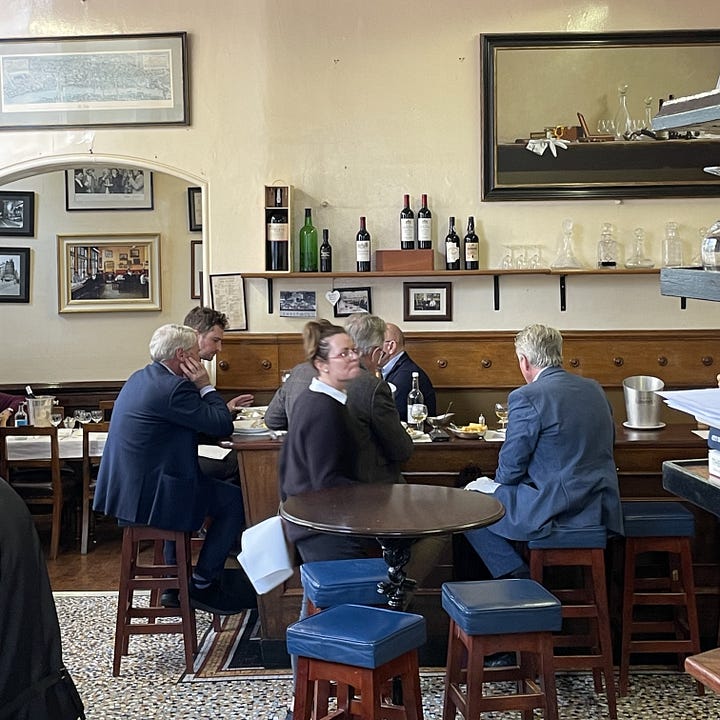
The other day we got to thinking about institutional restaurants and what makes one, well, one. Is it age? Cloth napkins? Multiple sauce options? In an age of natural wine bars and small plates (don’t get us wrong, we too enjoy a natty gamay and a plate of clams any day), we wanted to circle back on some old establishments that have given us, and many generations of Londoners, joy over the years.
Keeping it focused on seafood and with the prerequisite that these places needed to: 1. have been around for at least 100 years, and 2. serve a shrimp cocktail.
Sweetings - Open since 1889 for lunch from Monday to Friday, Sweetings sits in a Grade II listed building at the corner of Queen Victoria Street in the middle of the City. No reservations are taken and it is always packed on a Friday. Wine is brought to the table in silver buckets and sits beside silver sauce boats filled with tartare sauce to accompany your fish dish. Navy gilet - optional only.
J Sheekey - In 1896, the Prime Minister Lord Salisbury granted Josef Sheekey permission to serve fish and shellfish in St Martin’s Court, a small back-street in Theatreland, in exchange for catering for post-theatre supper parties. This marked the birth of “Sheekey's.” The perfect place to stop pre- or post-theatre still, the wood panelling and red alcove tables make this place always feel like a treat. Get the fish pie! Also good set menu options.
Wilton’s - The oldest restaurant on our list, established in 1742 at first as an oyster barrow and shellfish monger catering to the local ‘Haymarket’ - the market buying and selling hay and straw for horses. It still is very much London’s home for oysters which you can slurp (humpf, just realised how weird the word ‘slurp’ is) down with a nice chilled glass of muscadet when you are feeling festive; or just on a regular Tuesday if that's your pace.
Scott’s - A Mayfair institution, Scott’s was also originally an oyster warehouse in Haymarket created in 1851 before relocating to Mayfair. On a sunny day, lunch on the terrace here can’t be beat!
And for when you feel like bringing a bit of institution home with you, the oldest of the lot, Old Billingsgate fish market, officially established in 1698. Go early to pick up a seafood feast. Make sure you ask them to gut or descale your fish as you might find yourself doing this last minute in a cocktail dress while watching a YouTube video if you are like me.
ART: TURN END
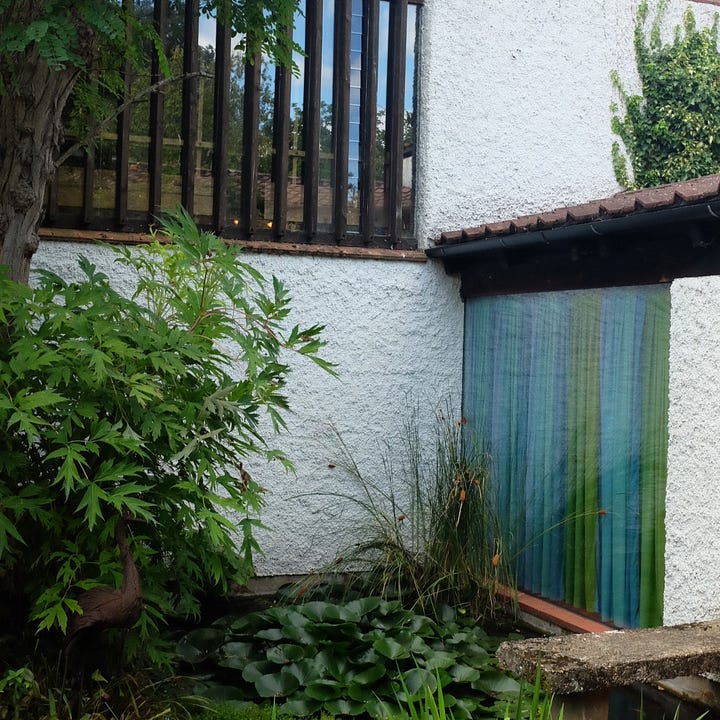
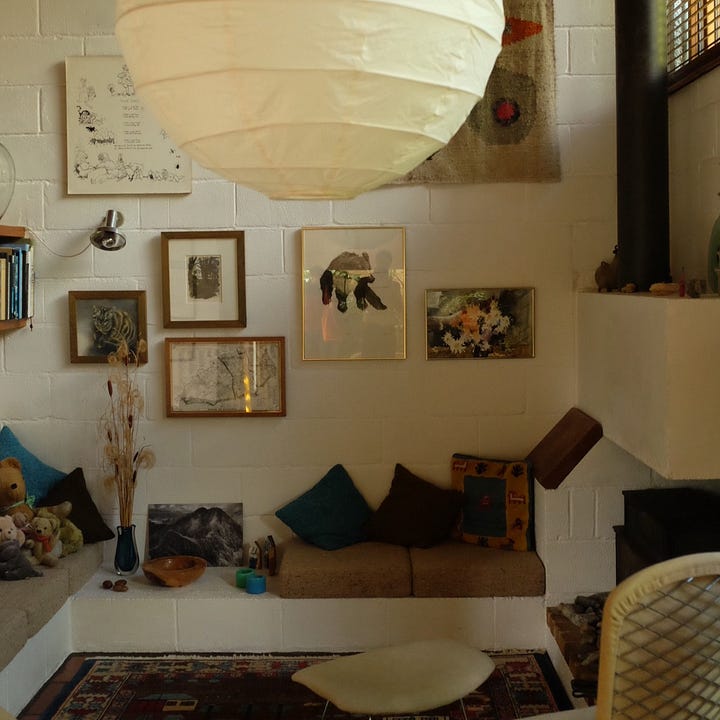
“I’m a ‘doer’, a maker of buildings; not an intellectualiser or theoriser.” - so self-describes Peter Arlington. As an architect, he has designed more listed buildings than any other living architect. Most famous among these is the set of three houses he designed and self-built, with his wife Margaret, at Haddenham in Buckinghamshire between 1964 and 1967: the Turn, Middle Turn, and Turn End. The latter is their own home, where they have lived ever since.
Now Grade II* listed, the humble single- or double-storey homes are simple - yet designed with great care. They showcase an honest use of plain materials with tiled floor, exposed soft timber beams and white painted unadorned blockwork - the result of much of the building work done by the architect himself with limited means. High-level windows and concertina doors bring sunlight from multiple aspects, morning to dusk; and a sense of airiness. The objectively small spaces are made to feel expansive by natural light, reinforced by a blurring of the lines between outside and in, notably with a uniform floor finish with no demarcation between the houses interior and their private courtyards.
The result has an air of mid-century modern Californian homes, with white walls and exposed woods; imbued in timeless charm and a sense of tranquillity. I’d be remiss if I didn’t mention the masterpiece of a garden around which the houses are nestled.
The houses are still in use and visits are rare. The next open day will be the late Summer bank holiday Sunday (25th August) - mark the date and book here. In the meantime, if you can spare six minutes; this short documentary is well worth it.
TRAVEL: ARLES
Our very first trip abroad together took us to Arles, in the South of France. Whilst perhaps less of a ‘destination’ than other coastal cities like Nice, Marseille or Cannes, Arles is actually the perfect spot to get a hit of culture, beach, food, as well as being located nicely between the Camargue and Provence without being overcrowded. Note that renting a car to get around does make life easier to visit surrounding areas.
Stay:
Les Cabanettes - We posted about this gem on our IG a while back and continue to fall under its spell whenever we look back at photos. A converted 1960s Best Western motel now classé as a XXth century patrimoine; the couple running it, Gaëlle & Aaron, have maintained the simplicity of the design of the space while bringing it into the 21st century. Modernist furniture is casually dotted throughout the hotel (think Bruno Rey green chairs in the dining room) with a standout restaurant serving natural wines in the evenings.
L’Arlatan - If you want an option more in the city.
Le Voltaire - Clean design and well priced, also more centrally located.
Do:
Les Rencontres de la Photographie d’Arles - Every summer since 1970, this international festival of photography takes over the old Roman city. Unused and unusual spaces throughout the city are used to exhibit photographers from around the world. The collection is vast and you can spend days going to all of the spots. Opens first week of July.
Château La Coste - An hour(ish) drive from Arles, sits this vineyard filled with an impressive 5 restaurants (including a Tadao Ando designed one) and sculpture garden with works from Louise Bourgeois to Alexander Calder. Go for the art, not necessarily the wine. Plus you can then pop into nearby Aix-en-Provence for a bite at Les Vieilles Canailles and a visit to Atelier Cézanne.
Fondation Vincent Van Gogh - the painter, tired of living in Paris, settled in Arles in 1888. Many of his famous paintings originated here; so did the ear cutting episode.
LUMA holds exhibitions of major artists in a unique setting of former train manufacturing lines; and now features a new building by Frank Gehry.
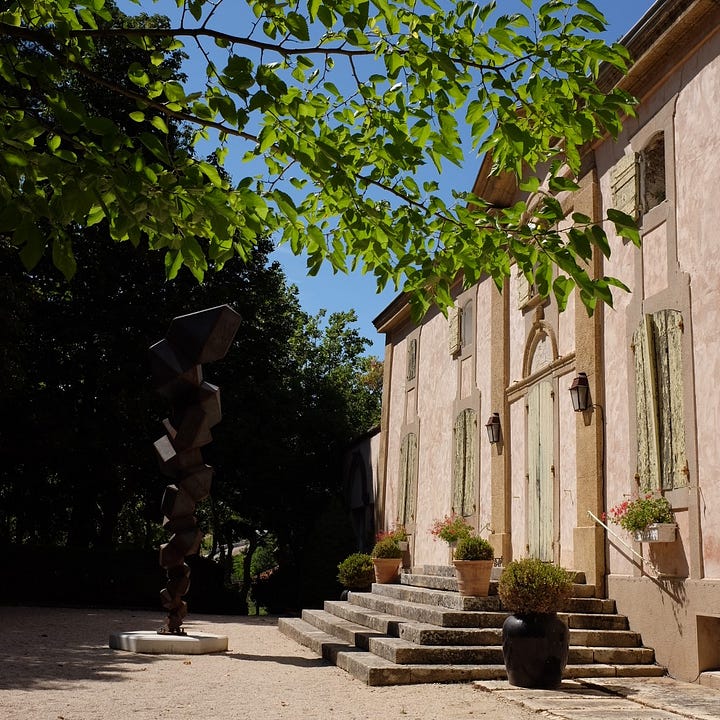

Eat:
Chardon - With their impressive team the restaurant welcomes rotating chefs to create seasonal set tasting menus. Take a table outside under the fairy lights. Book in advance.
Le Gibolin - Cute bistrot serving homemade local food, nice selection of natural wines.
Le Buste et L’oreille - Wine bar and library. The reference to Van Gogh wouldn’t have passed you by.
Le Voltaire - Restaurant in the hotel with rotating guest chefs.



